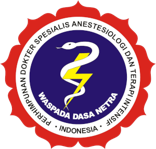Anesthesia Management in VP Shunt Surgery in Neonates with Hypoplastic Left Heart Syndrome (HLHS) and Dandy Walker Syndrome
Abstract
Introduction: Hypoplastic left heart syndrome (HLHS) is defined as the incomplete development of the left heart structures, including the mitral valve, left ventricle, aortic valve, and aortic arch. The clinical presentation of HLHS depends on the patency of the ductus arteriosus and the degree of restriction of the atrial septum. Common clinical manifestations include cyanosis, respiratory distress, and hemodynamic instability within hours of delivery. Delays in diagnosis and delay in intervention will increase the morbidity of neonates with HLHS.
Purpose: To understand the mechanism of HLHS along with the principles of anesthesia in neuroaesthetics procedures in pediatrics in order to obtain a good outcome.
Case Illustration: A 9-day old baby girl, weight 2522 grams with HLHS (aortic atresia) with patent ductus arteriosus (PDA), type II atrial septal defect (ASD) with a left to right shunt, and dandy walker syndrome. From the physical examination, the patient's condition is stable, with GCS E4V5M6, pulse 130-135 beats/minute, breath rate 48x / minute, and SpO2 94-98%. The patient's head was enlarged from birth, no heart sounds were found, regular I-II heart sounds. Blood laboratory tests showed a total bilirubin value of 11.7 mg / dL, direct bilirubin 0.64 mg / dL, indirect bilirubin 10.43 mg / dL, hemoglobin 20.1 g%, hematocrit 55%, with leukocytes 19.9x103 / L, platelets 216 x 103 / L, serum Na 122 mmol / L, K 7.8 mmol / L, Cl 101 mmol / L.
Discussion: The anesthetic approach in HLHS is to maintain preoperative hemodynamic stability by maintaining heart rate, preload, and PGE1, balancing systemic vascular resistance and pulmonary vascular resistance, preventing too high PaO2, and administering inotropic agents to increase cardiac output and keep the patent ductus arteriosus open. The balance of systemic and pulmonary blood flow is a key principle in the management of HLHS anesthesia.
Conclusion: The main goal of HLHS anesthesia is to minimize hemodynamic changes to prevent compromised hemodynamics in both circulations and maintaining stability is essential in preventing morbidity, complications, and increasing good outcomes in surgery..
Keywords
Full Text:
PDFReferences
Yabrodi M, Mastropietro CW. Hypoplastic left heart syndrome: From comfort care to long-term survival. Pediatr Res. 2017;81(1–2):142–9. 2. Javed R, Cetta F, Said SM, Olson TM, O’Leary PW, Qureshi MY. Hypoplastic leftheart syndrome: An overview for primary care providers. Pediatr Rev. 2019;40(7):344–53. 3. Twite MD, Ing RJ. Anesthetic considerations in infants with hypoplastic left heart syndrome. Semin Cardiothorac Vasc Anesth. 2013;17(2):137–45. 4. Benson DW, Martin LJ, Lo CW. Genetics of hypoplastic left heart syndrome. J Pediatr. 2016;173:25–31. 5. Grossfeld PD. Hypoplastic Left Heart Syndrome. It Is All in the Genes**Editorials published in the Journal of the American College of Cardiology reflect the views of the authors and do not necessarily represent the views of JACC or the American College of Cardiology. J Am Coll Cardiol [Internet]. 2007;50(16):1596–7. Available from: http://www.ncbi.nlm.nih.gov/pubmed/17936160 6. Tchervenkov CI, Jacobs JP, Weinberg PM, Aiello VD, Béland MJ, Colan SD, et al. The nomenclature, definition and classification of hypoplastic left heart syndrome. Cardiol Young. 2006;16(4):339–68. 7. Mohanty SR, Patel A, Kundan S, Radhakrishnan HB, Rao SG. Hypoplastic left heart syndrome: current modalities of treatment and outcomes. Indian J Thorac Cardiovasc Surg [Internet]. 2021 Jan 11;37(S1):26–35. Available from: http://link.springer.com/10.1007/s12055-019-00919-7 8. Naguib AN, Winch P, Schwartz L, Isaacs J, Rodeman R, Cheatham JP, et al. Anesthetic management of the hybrid stage 1 procedure for hypoplastic left heart syndrome (HLHS). Pediatr Anesth [Internet]. 2010 Jan;20(1):38–46. Available from: http://doi.wiley.com/10.1111/j.1460-9592.2009.03205.x 9. Baker-Smith CM, Neish SR, Klitzner TS, Beekman RH, Kugler JD, Martin GR, et al. Variation in Postoperative Care following Stage I Palliation for Single-ventricle Patients: A Report from the Joint Council on Congenital Heart Disease National Quality Improvement Collaborative. Congenit Heart Dis. 2011;6(2):116–27. 10. Hoffman TM, Wemovsky G, Atz AM, Kulik TJ, Nelson DP, Chang AC, et al. Efficacy and safety of milrinone in preventing low cardiac output syndrome in infants and children after corrective surgery for congenital heart disease. Circulation. 2003;107(7):996–1002. 11. Li J, Zhang G, Holtby H, Humpl T, Caldarone CA, Van Arsdell GS, et al. Adverse Effects of Dopamine on Systemic Hemodynamic Status and Oxygen Transport in Neonates After the Norwood Procedure. J Am Coll Cardiol. 2006;48(9):1859–64.
Refbacks
- There are currently no refbacks.








